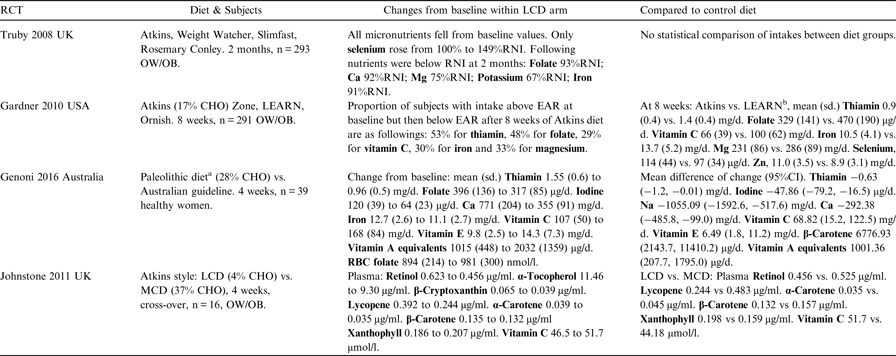Low-carbohydrate diets (LCD) are increasingly used and promoted for weight management(Reference Noakes and Windt1). Limiting carbohydrate-rich foods such as wholegrains and cereals may reduce consumption of B-vitamins and minerals, even causing beri-beri with extreme carbohydrate (CHO) avoidance(Reference McKenna, Drummond and Drummond2).
Studies of LCDs reporting micronutrient intake and status were systematically reviewed. Web of Science, Medline (OVID), EMBASE (OVID), Scopus, Cochrane Library and ClinicalTrials.gov were searched from inception to September 2017. Two reviewers independently performed study selection and data extraction. After duplicate removal, 475 titles and abstracts were considered, and 47 were selected for full-text screening. Five studies met the inclusion criteria (studies of LCDs; reporting on micronutrient intake and status) for the review.
The cross-sectional study of Icelandic adults voluntarily following LCD (average 8%E from CHO) reported consumptions below recommended daily intakes for thiamin, folate, vitamin C, calcium, magnesium and iron in 50% of women, thiamin and folate in 25% of men, and iron and magnesium in 75% of men(Reference Elidottir, Halldorsson and Gunnarsdottir3). RCTs (n = 4) findings are tabulated.

LEARN: Lifestyle, Exercise, Attitudes, Relationships, Nutrition; OW/OB: overweight and obesity; MCD: medium carbohydrate diet
aPaleolithic diet: omit grains, cereals, legumes, white potato, corn and dairy products.
A limited number of studies reported on micronutrient status and intakes, with varying definition of what constitutes a LCD (varying CHO intakes, always below 45%E). Reduced intakes of thiamin, magnesium, calcium, iron and iodine are noteworthy, compared to within-group baseline or control diets – however, adverse effect related to micronutrient deficiencies were not reported for any of the studies. Longer-term studies focusing on biological markers of micronutrient status with a standardised definition of LCD are needed.


